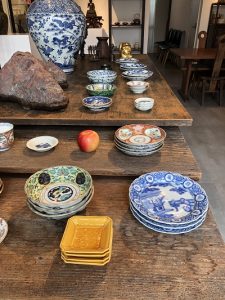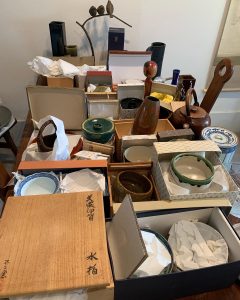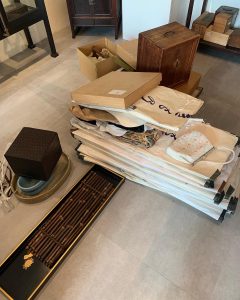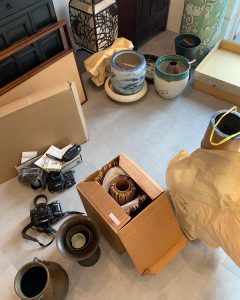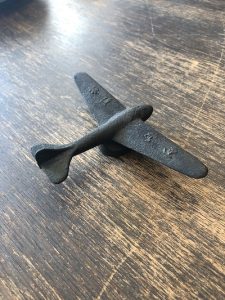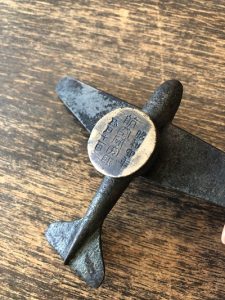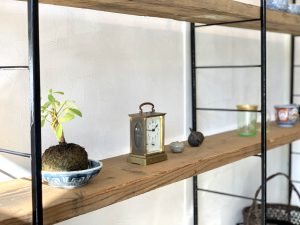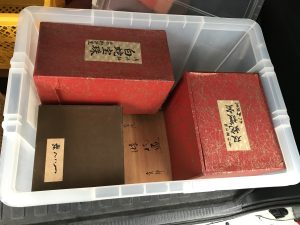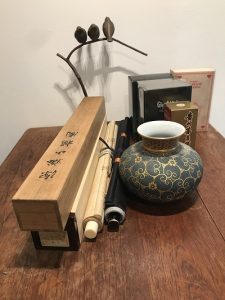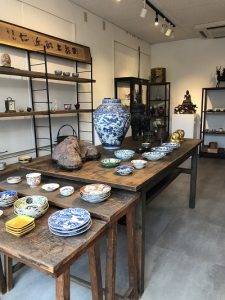さて、みなさま、こんにちはスタッフNでございます。
一難去ってまた一難、また台風が来ているようですね。
世間は3連休ですが、フェスやイベントなども中止になり、落ち込んでいる方も多いのではないでしょうか。
残念ながらNは仕事でございます。
雨の覚王山を眺めながら雨音の中での仕事も、風情があってよいものでございます。
最近Nはyoutubeを見ながら、ダンスやら筋トレやらをしているのですが、知人に教えてもらったボディコンバットというものをしてみました。
が、きつすぎて5分もたたず心臓がバクバク、限界でございました。
なんだかリビングの床もきしみはじめ、Nの前にリビングの床がぬけるかもしれませんので、ここいらでやめておこうと思います。
けしてトレーニングをさぼっているわけではありません、床が心配ゆえでございます。笑
さて、先日沖縄に行ってきた知り合いから、沖縄のペアグラスの写真が届きました。
夫婦でお揃いにしたそうです、素敵でございますね。
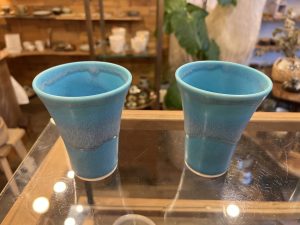
見事なターコイズブルー、沖縄の海を思い出しそうです。
綺麗な水色と言えば、今日は海王星の日だそうです。
水金地火木土天海冥は知っているのですが、それぞれの惑星の特徴はわかりません。
Nはセーラームーンのあのキャラクターだな、くらいに思っております。
海王星のキャラクターは、セーラーネプチューン、海王みちる。
子供のころは、そんな知的で上品な才色兼備な女性を夢見ておりましたが、実際はドジで泣き虫な主人公の月野うさぎよりになってしまいました。
人生そう思い通りにはいきませんね。
セーラームーンの話は置いといて、せっかくなので海王星について調べてみました。
海王星(かいおうせい、英語: Neptune )は、太陽系の第8惑星で、太陽系の惑星の中では一番外側を公転しております。
直径は4番目、質量は3番目に大きく、地球の17倍の質量を持ち、太陽系のガス惑星としては最も密度が高いです。
海王星は、直径がやや大きい天王星の質量(地球の15倍)よりもわずかに大きく、164.8年かけて公転しており、太陽からは平均30.1 au(約45億 km)離れております。
名称は、ローマ神話における海神ネプトゥーヌスに因んで命名され、惑星記号「♆」はネプトゥーヌスが持つ三叉槍を様式化したものでございます。
肉眼で観望することは出来ず、太陽系において唯一、経験的観測でなく数学的予測によって発見された惑星でございました。
フランスの天文学者アレクシス・ブヴァールは、天王星の軌道の予期せぬ変化から、天王星の軌道が未知の惑星の重力による摂動のために生じているという推論を導きました。
その後、ユルバン・ルヴェリエによって予測された範囲内の位置で1846年9月23日にヨハン・ゴットフリート・ガレが望遠鏡を用いて発見いたしました。
海王星の衛星では最大のトリトンは、その後間もなく発見されました。
現在では他に13個の衛星が知られているものの、地球から海王星までの距離が大きく地上からの観測が困難なため、それらの存在が明らかとなったのは20世紀以降のことでした。
1989年8月25日、宇宙探査機ボイジャー2号が海王星を訪れ、フライバイを行いました。
(フライ‐バイ【fly-by】 とは、宇宙船や探査機が天体近傍を接近通過すること。 接近する短時間の間に各種探査を行う。 また、天体の万有引力を利用して加速・減速・方向転換を行うスイングバイを指すこともある。)
ハッブル宇宙望遠鏡や補償光学機能を備えた大型の地上望遠鏡の登場によって、近年は遠方からの更なる観測が可能になっているそうです。
水やメタン、アンモニアなどの「氷」の割合は大きいものの、木星や土星と同様に海王星の大気は主に水素やヘリウム、そして微量の炭化水素と窒素で構成されております。
しかし、天王星と同様にその内部は氷と岩石で構成されております。
そのため通常は、天王星と海王星は木星、土星との違いを強調して天王星型惑星(巨大氷惑星)とみなされております。
海王星の青い外観は、最も外側の領域に存在している微量のメタンによって作り出されているとされてております。
霞んだ、比較的特徴を欠いている天王星の大気とは対照的に、海王星の大気は活発で、明確な変化が見られる気候を持ちます。
例えば、1989年にボイジャー2号がフライバイを行った時点では、南半球に木星の大赤斑に類似した大暗斑と呼ばれる模様が存在していました。
これらの気象パターンは、太陽系のどの惑星よりも強い持続的な風によって引き起こされ、観測された風速は2100 km/h(580 m/s)にもなります。
太陽からの距離が遠いため、海王星の外側の大気は太陽系で最も温度の低い場所の1つであり、雲頂での温度は55 K(-218 ℃)に近いのに対して、惑星の中心部の温度は約5400 K(約5100 ℃)になっていると考えられています。
海王星は微かで断片的な環を持っており、この環は1984年に発見され、後にボイジャー2号の観測でも確認されました。
望遠鏡を通じて記録されたこれまでで最も初期の観測記録の一部である、1612年12月28日と1613年1月27日にガリレオ・ガリレイが描いた図面には、海王星が位置していた地点が記されていました。
しかし、どちらの場合もガリレオは海王星を、合を起こしている木星の近くにある恒星と誤って認識していたとされております。
したがって、ガリレオは海王星を発見したとはみなされておりません。
青く見えるのは海王星に海があるからではなく、表層のガスに含まれるメタンのためでございます。
メタンは赤い色を吸収して青い色を散乱する性質があり、太陽光のなかの青い光が反射されているのです。
暴風の横じまや大暗斑を見せる海王星は、「青い木星」とも言えるのです。
そして海王星のこの過酷で異様な環境下では、大気を形成するメタン(CH4)が分離して炭素が高圧で変質しダイヤモンドとなり、中心核に向かって降下する「ダイヤモンドの雨」が降り注いでいます。
ダイアモンドが降りそそぐなんて、ロマンチック~と一瞬思いましたが、普通に考えたら危険ですね。
海王星の明るさは約8等級で、空が暗ければ双眼鏡や小型の天体望遠鏡でも見つけられるそうです。
雨が止んだら夜空を見上げて、海王星を探してみてはいかがでしょうか?
古美術風光舎では、焼物、ブランド食器などの買取もしております。
ではでは
Hello everyone, this is Staff N.
It seems that another typhoon is coming after one disaster has passed.
It’s been a three-day weekend in the world, but festivals and events have been canceled, and I think many people are depressed.
Unfortunately, N is at work.
Working in the sound of rain while gazing at Mt.
Recently, N has been doing dance and muscle training while watching youtube, and I tried something called body combat that an acquaintance taught me.
However, it was too tight and my heart was pounding in less than 5 minutes.
The floor in the living room is starting to creak, and the floor in the living room may come out before N, so I think I’ll stop here.
It’s not that I’m skipping training, it’s because I’m worried about the floor. smile
Well, the other day, I received a picture of Okinawa’s pair glasses from an acquaintance who went to Okinawa.
It seems that the couple has been matched, it is wonderful.
Stunning turquoise blue, it seems to remind me of the sea of Okinawa.
Speaking of beautiful light blue, it seems that today is Neptune’s day.
I know water, metal, fire, wood, earth, and heaven and earth, but I don’t know the characteristics of each planet.
I think that N is that character of Sailor Moon.
Neptune characters are Sailor Neptune and Kaioh Michiru.
When I was a child, I dreamed of such an intelligent, elegant, talented woman, but in reality, I ended up with the clumsy and crybaby Usagi Tsukino.
Life doesn’t always go as planned.
Leaving aside the story of Sailor Moon, I tried to find out about Neptune.
Neptune (English: Neptune) is the eighth planet in the solar system and is the outermost planet in the solar system.
It is the fourth largest in diameter and the third largest in mass, with 17 times the mass of Earth and the densest gas planet in the solar system.
Neptune is slightly larger than the slightly larger Uranus (15 times the mass of Earth), orbits it for 164.8 years, and is an average of 30.1 AU (about 4.5 billion km) from the Sun.
The name is named after Neptune, the god of the sea in Roman mythology, and the planet symbol “♆” is a stylized trident held by Neptune.
It was the only planet in the solar system that could not be observed with the naked eye and was discovered not by empirical observation but by mathematical prediction.
French astronomer Alexis Bouvard has led the inference that the orbit of Uranus is caused by perturbations by the gravitational force of an unknown planet from unexpected changes in the orbit of Uranus.
It was later discovered by Johann Gottfried Galle using a telescope on September 23, 1846, within the range predicted by Urbain Le Verrier.
Neptune’s largest moon, Triton, was discovered shortly thereafter.
Although 13 other moons are known at present, their existence was revealed only after the 20th century because the distance from the Earth to Neptune is so large that it is difficult to observe them from the ground.
On August 25, 1989, the space probe Voyager 2 visited Neptune and performed a flyby.
(Fly-by means that a spacecraft or probe passes close to a celestial body. Various explorations are performed in a short period of time.・It may also refer to a swing-by that changes direction.)
With the advent of the Hubble Space Telescope and large ground-based telescopes equipped with adaptive optics functions, it seems that in recent years it has become possible to perform further observations from a distance.
Like Jupiter and Saturn, Neptune’s atmosphere is mainly composed of hydrogen and helium, with trace amounts of hydrocarbons and nitrogen, although there is a large proportion of “ice” such as water, methane, and ammonia.
However, like Uranus, its interior is composed of ice and rock.
Therefore, Uranus and Neptune are usually regarded as Uranus-type planets (ice giant planets), emphasizing the difference from Jupiter and Saturn.
Neptune’s blue appearance is thought to be caused by trace amounts of methane present in its outermost regions.
In contrast to the hazy, relatively featureless atmosphere of Uranus, Neptune’s atmosphere is active and has a distinctly variable climate.
For example, when Voyager 2 flew by in 1989, there was a pattern called the Great Dark Spot similar to Jupiter’s Great Red Spot in the southern hemisphere.
These weather patterns are caused by the strongest and most persistent winds of any planet in the solar system, with observed wind speeds as high as 2100 km/h (580 m/s).
Because of its great distance from the Sun, Neptune’s outer atmosphere is one of the coldest places in the solar system, with temperatures close to 55 K (-218 °C) at the cloud tops, compared to temperatures in the planet’s core. is believed to have a temperature of about 5400 K (about 5100 °C).
Neptune has faint and fragmentary rings that were discovered in 1984 and later confirmed by Voyager 2 observations.
Drawings made by Galileo Galilei on December 28, 1612 and January 27, 1613, some of the earliest observations ever recorded through a telescope, show where Neptune was located. was written.
In both cases, however, Galileo is said to have mistakenly identified Neptune as a nearby star to the conjunct Jupiter.
Galileo is therefore not credited with discovering Neptune.
The reason why it looks blue is not because Neptune has an ocean, but because of the methane contained in the surface gas.
Methane absorbs red colors and scatters blue colors, so the blue light in sunlight is reflected.
Neptune, which shows the horizontal stripes of storms and the Great Dark Spot, can also be called “blue Jupiter.”
In this harsh and bizarre environment of Neptune, methane (CH4), which forms the atmosphere of Neptune, separates and the carbon transforms into diamonds under high pressure. .
For a moment, I thought it would be romantic to see diamonds pouring down, but if you think about it normally, it’s dangerous.
Neptune has a brightness of about 8th magnitude, and if the sky is dark, it can be found with binoculars or a small astronomical telescope.
When the rain stops, why not look up at the night sky and look for Neptune?
At Antique Fukousha, we also purchase pottery and brand tableware.
See you soon
*********************
ご実家の整理やお片付けなどをされている方のご相談などが多くございます。朝晩少し涼しい季節となってまりましたが、でくれぐれもご無理のないようになさってくださいませ。風光舎では古美術品や骨董品の他にも絵画や宝石、趣味のお品など様々なジャンルのものを買受しております。
お片付けをされていて、こういうものでもいいのかしらと迷われているものでも、どうぞお気軽にご相談下さいませ。
また風光舎は、出張買取も強化しております。ご近所はもちろん、愛知県内、岐阜県、三重県その他の県へも出張いたします。
まずは、お電話お待ちしております。
愛知県名古屋市千種区・骨董 買取
『古美術 風光舎 名古屋店』
TEL052(734)8444
10:00-17:00 OPEN
#海王星 #古美術 #骨董 #買取
